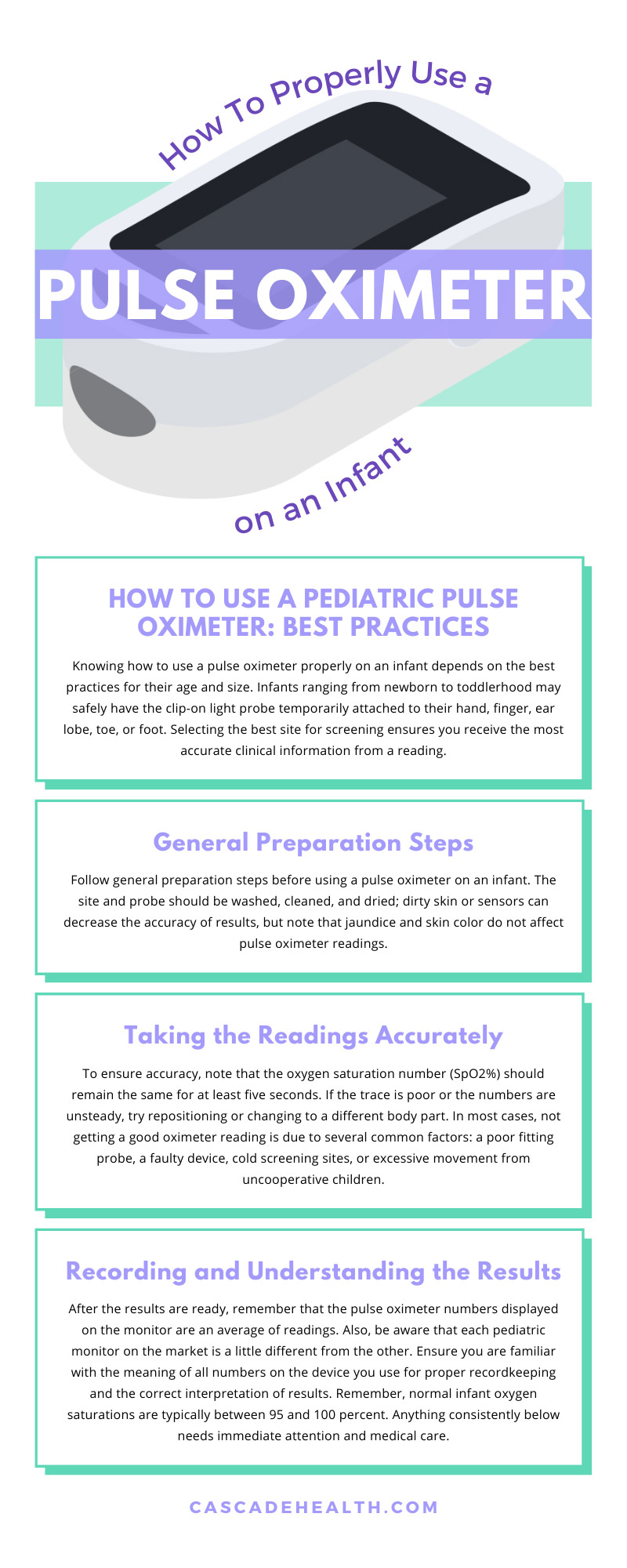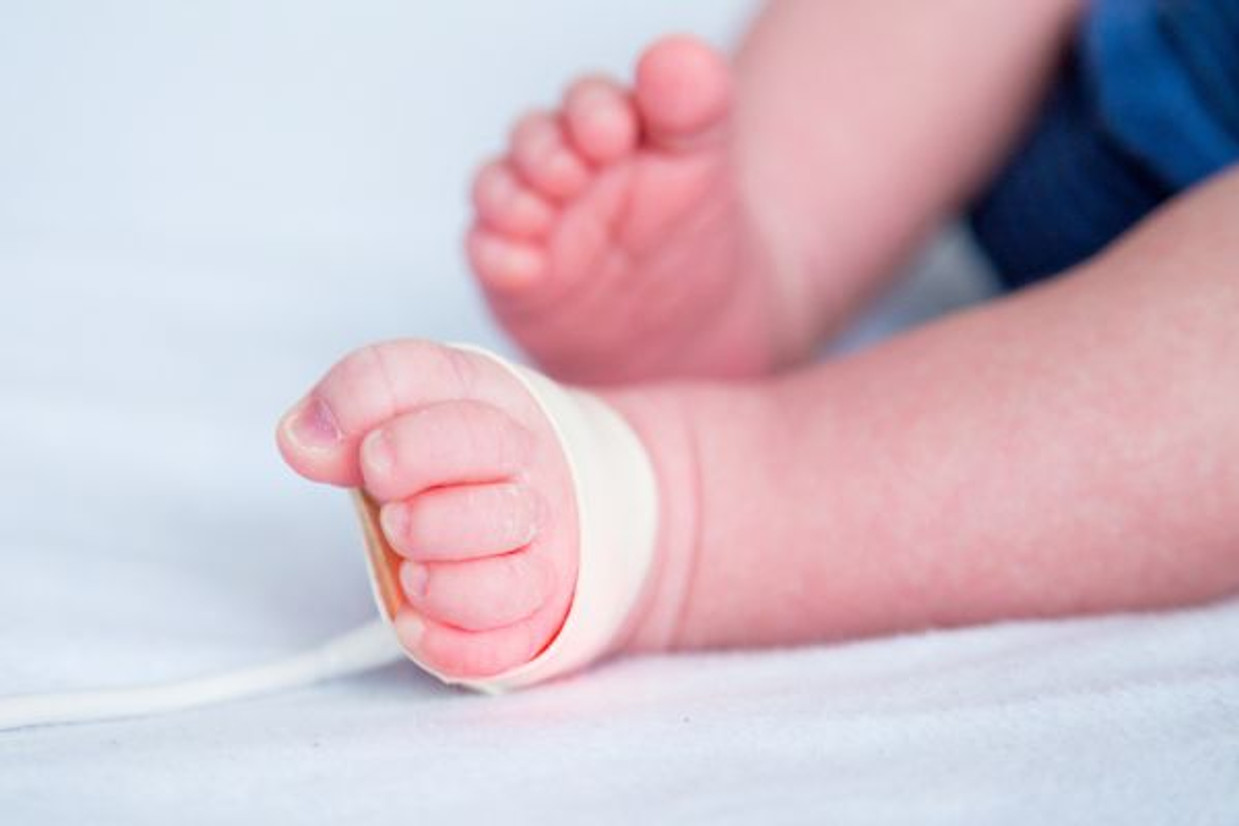How To Properly Use a Pulse Oximeter on an Infant
Pulse oximetry is a routine testing tool for healthcare applications. During this examination, a small pulse oximeter device wraps around a bodily extremity to measure an individual’s blood oxygen levels. A simple pulse oximetry test—alongside other indicators and clinical symptoms—can correctly reveal if a young child is hypoxemic.
The presence of hypoxemia—insufficient oxygen in the blood—indicates to healthcare staff that an infant may be suffering from a breathing, lung, or heart problem. Any condition that restricts blood flow or reduces the amount of blood oxygen levels below the normal range can lead to serious or fatal health consequences.
Understanding how to use this medical device plays a vital role in patient care and monitoring. Fortunately, a pulse oximeter is straightforward to use and does not require special training. Many people keep a pulse oximeter in their home. However, users need background knowledge for the proper application on an infant. Let’s closely examine how to use a pulse oximeter on an infant properly.
The Basic Concept of Pulse Oximetry
Pulse oximetry tests measure the percentage of oxygenated hemoglobin in arterial blood to provide valuable clinical data with speed and precision. How does this rapid estimation process work? By innovative function and design, of course.
The oximeter probe acts both as an infrared light emitter and a detector. The device temporarily shines the light through an individual’s skin to evaluate how much of the blood within contains that vital oxygen saturation. Then, the device calculates blood oxygen levels based on light absorption.
What To Know About Pulse Oximetry Measurement
Pulse oximetry is a non-invasive, needlestick-free, and radiation-free type of measurement testing. There are no known associated risks for adults or children. It’s one of the most important screenings for a newborn.
Using a pulse oximeter to serve as a test to look for a certain condition or a monitoring test to evaluate current symptoms, the device is able to measure an infant’s oxygen saturation levels (SpO2) and pulse rate. Consider the differences between these readings for proper point of care.
Standard Pulse: BPM
Pulse rate refers to the estimated measurement of how fast an infant’s heart beats, or how many times their heart contracts per minute. A pulse oximeter measures the pulse of a young child in beats per minute (bpm) and will reveal this number on the screen as bpm or PRbpm. The average heart rate range for infants is approximately 100–160 beats per minute.
Blood Oxygen Levels: The Fifth Vital Sign
Suggested by medical professionals as the fifth vital sign—alongside body temperature, respiration rate, blood pressure, and pulse rate—blood oxygen saturation is essential to detect or monitor medical problems in young infants. Again, oxygen saturation level refers to the estimated measurement of the amount of oxygen carried in red blood cells.
During a pulse oximetry test, the device measures oxygen saturation as a percentage and scores the number out of 100. A pulse oximeter will typically read this number as SpO2%. In a healthy infant, normal SpO2 is around 95–100 percent. SpO2 below 90 percent is a clear indicator of hypoxemia that requires supplemental oxygen. SpO2 should be kept above this 90 percent marker at all times for young children.
How To Use a Pediatric Pulse Oximeter: Best Practices
Knowing how to use a pulse oximeter on an infant properly depends on the best practices for their age and size. Infants ranging from newborn to toddlerhood may safely have the clip-on light probe temporarily attached to their hand, finger, ear lobe, toe, or foot.
Selecting the best site for screening ensures you receive the most accurate clinical information from a reading. The recommended placement for a small pediatric pulse oximeter probe—not an adult clip—is around the outer palm or the foot. The soft sensor will not harm or bother the child.
General Preparation Steps
Follow general preparation steps before using a pulse oximeter on an infant. The site and probe should be washed, cleaned, and dried; dirty skin or sensors can decrease the accuracy of results, but note that jaundice and skin color do not affect pulse oximeter readings.
Before taking a reading, ensure that the child rests for at least five minutes. The child should be calm with still arms and legs, as any movement, shivering, or crying can affect the results. When placed on the hand or foot, double-check that the emitter side of the pulse oximeter probe directly aligns with the detector side. There should be no gaps left between the skin and the probe sensor.
Taking the Readings Accurately
After turning the pulse oximeter on and checking that the display screen lights up, place the probe gently on the testing sight. Keep the body part still and wait for a minute or two until the oximeter displays a steady pulse waveform.
To ensure accuracy, note that the oxygen saturation number (SpO2%) should remain the same for at least five seconds. If the trace is poor or the numbers are unsteady, try repositioning or changing to a different body part. In most cases, not getting a good oximeter reading is due to several common factors: a poor fitting probe, a faulty device, cold screening sites, or excessive movement from uncooperative children.
Recording and Understanding the Results
After the results are ready, remember that the pulse oximeter numbers displayed on the monitor are an average of readings. Also, be aware that each pediatric monitor on the market is a little different from the other.
Ensure you are familiar with the meaning of all numbers on the device you use for proper recordkeeping and the correct interpretation of results. Remember, normal infant oxygen saturation levels are typically between 95 and 100 percent. Anything consistently below needs immediate attention and medical care.
High-Sensitivity Pulse Oximeters
Modern pulse oximeters can be used for professional inpatient and outpatient care alongside personal use to measure one’s oxygen level at home. Investing in a top-quality, highly sensitive device ensures users receive the most accurate insights on SpO2 and heart rate for their applications.
Cascade Health Care is a trusted supplier of first-rate healthcare equipment and supplies. Our online selection includes a medical-grade infant pulse oximeter from the top manufacturer Masimo. Featuring built-in pediatric sensors, this lightweight handheld device is suitable for professional monitoring in clinical settings. We also carry an easy-to-use fingertip pulse oximeter from ADC for pediatric point-of-care. Browse our available options or reach out to our customer service team with any questions today.

Recent Posts
-
Exploring Recent Innovations in Doppler Signal Processing
Doppler technology has become an essential diagnostic tool in modern medicine, enabling healthcare p
-
Exploring Recent Innovations in Doppler Signal Processing
Doppler technology has become an essential diagnostic tool in modern medicine, enabling healthcare p


